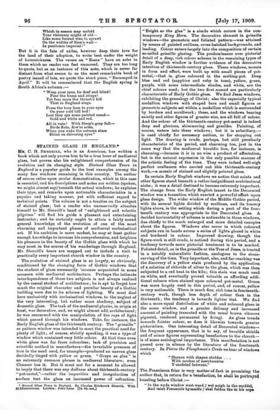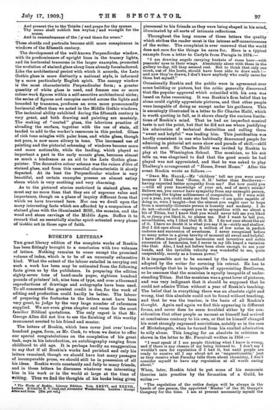STAINED GLASS IN ENGLAND.*
Ms. C. H. SHERRILL, who is an American, has written a book which not only Droves him to be a true lover of mediaeval glass, but proves also his enlightened comprehension of its evolution and its changing style. Stained Glass Tours in England is a popular guide to the best examples among the many fine windows remaining in this country. The author of course relies upon ocular demonstration, which in this case is essential, and his descriptions and notes are written (spoken, we might almost say) beneath the actual windows; he explains their type, and remarks upon noticeable characteristics in a popular and taking manner, yet with sufficient regard to technical points. The volume is not a treatise on the subject of stained glass; but a reader who unreservedly attaches himself to Mr. Sherrill's band of "enlightened and eclectic pilgrims" will find his guide a pleasant and entertaining instructor; and he certainly ought to attain a fairly sound general knowledge of the evolution of one of the most charming and important phases of mediaeval ecclesiastical art. If his ambition is more modest, he may at least gather enough knowledge to increase his comprehension, and heighten his pleasure in the beauty of the Gothic glass with which he may meet in the course of his wanderings through England. Mr. Sherrill's tours are mapped out to include a visit to practically every important church window in the country.
The evolution of stained glass is so largely, so obviously, conditioned by the changing form of Gothic windows that the student of glass necessarily ')ecomes acquainted in some measure with mediaeval architecture. Perhaps the intimate interdependence of these two subjects is not always realised by the casual student of architecture; he is apt to forget how much the original character and peculiar beauty of a Gothic building were due to its scheme of lighting. We must deal here exclusively with ecclesiastical windows, to the neglect of the very interesting, but rather more shadowy, subject of domestic glass. The task of the mediaeval glazier, in origin at least, was decorative, and, we might almost add, architectural; he was concerned with the manipulation of the rays of light which passed through his windows. Take, for instance, the Early English glass of the thirteenth century. The "grisaille" or pattern window was intended to meet the practical need for plenty of light ; of course, strictly speaking, it was a type of window which contained very little colour. At that time even white glass was far from colourless; lack of precision and scientific method in manufacture—the invariable presence of iron in the sand used, for example—produced an uneven glass decidedly tinged with yellow or green. " Greye as glas " is an extremely Common phrase in mediaeval literature; even Chaucer has it. But it must not for a moment be allowed to imply that there was any dullness about thirteenth-century "pot-metal"—rather the impurities and irregularities of surface lent the glees an increased power of refraction.
• Stained Glass Tour. in England. By Charles Hitchcock Sherrill. With 16 Illustrations. London: John Lane. [7s. 6d. net.] "Bright so the glee is a simile which occurs in the con- temporary King Horn. The decorative element in grisaille windows—the geometric and foliated pattern—was attained by means of painted outlines, cross-hatched backgrounds, and leading. Colour enters largely into the composition of certain so-called grisaille glazing. The predominance over pictorial
detail of a deep, rich colour scheme in the remaining types of Early English window is further evidence of the decorative intention of thirteenth-century glass. These windows, mosaic in form and effect, were built up with small pieces of pot- metal,—that is, glass coloured in the melting-pot. Deep blue and red (sapphire and ruby in tone), yellow, green, purple, with some intermediate shades, and white, are the chief colours used ; but the two first named are particularly characteristic of Early Gothic glass. We find Jesse windows, exhibiting the genealogy of Christ; also the especially typical medallion windows with shaped bars and small figures or geometric subjects set within a medallion which is surrounded by borders and scrollwork; these, and the windows bearing saintly and other figures of greater size, are all full of colour. And the colour of the thirteenth-century pot-metal is indeed
deep and glorious, shimmering and gemlike. Painting, of course, enters into these windows ; but it is subsidiary,—
is used chiefly for necessary outline, or for stopping out light. The drawing is crude, perhaps, but still peculiarly characteristic of the period, and charming too, just in the same way that the mediaeval heraldic lion, for instance, is charming.—because it is in no wise a product of affectation, but is the natural expression in the only possible manner of the artistic feeling of the time. They were indeed well-nigh perfect craftsmen who carried out this thirteenth-century work,—a mosaic of stained and slightly painted glass.
In certain Early English windows we notice that saints and other figures stand beneath a rather insignificant architectural niche; it was a detail destined to become extremely important. The change from the Early English lancet to the Decorated window was a transition which exerted a powerful effect upon glass design. The wider window of the Middle Gothic period, with its several lights divided by mullions, and its tracery lights above, is the setting which during a part of the four- teenth century was appropriate to the Decorated glass. A decided borizontality of scheme is noticeable in these windows, due chiefly to the much enlarged and more detailed canopies about the figures. Windows also occur in which coloured subjects run in bands across a series of lights glazed in white and bordered in colour. Improved drawing, though the figure-work is still crude, is noticed during this period, and a tendency towards more pictorial treatment is to be marked.
Foliated detail, as in the grisaille or the Tree of Jesse, is treated in a notably naturalistic fashion, analogous to the stone- carving of the time. Very important, also, and far-reaching was the discovery of a yellow stain produced by the application of a solution of chloride of silver to the glass, which was then subjected to a red beat in the kiln; this stain was much used on white, and eventually proved valuable as affording addi- tional colours when stained upon coloured pot-metal. Green was more largely used in this period, and, of course, yellow is very noticeable. There is much fine, rich tone in fourteenth- century work, though less depth of colour than in the thirteenth ; the tendency is towards lighter tint. We find also a more equal distribution of white and coloured glass in the same window, and a greater delicacy and increased amount of painting (executed with the usual brown vitreous
pigment, rendered permanent by firing). As glass trends towards fainter colour, so does it likewise towards greater pictorialism. One interesting detail of Decorated windows— the frequent appearance, that is to say, of heraldic shields and of minor figures representing benefactors to the church—
is of some sociological importance. This manifestation is not passed over in silence by the literature of the fourteenth
century. In Pierce the Ploughman's Crede we hear of windows
which "Shynen with shapen sheldes . .
With merkes of merchauntes Y-medeled betwene."
The Franciscan friar is very matter-of-fact in promising the author that, in return for a benefaction, he shall be portrayed kneeling before Christ :— "In the wyde window west-ward / wel neigh in the myddel, And saint Frannceis hymselfe / shal folden the in his cope
- And present the to the Trinite / and praye for thy synnes. Thy name shall noblich ben wryten / and wrought for the nones,
And in remembraunce of the f -i-racl there for evere."
These shields and portraits become still more conspicuous in windows of the fifteenth century.
The development of the well-known Perpendicular window, with its predominance of upright lines in the tracery lights, and its horizontal transoms in the larger examples, promoted the evolution of stained glass along lines already foreshadowed. Like the architectural period with which it accords, the Late Gothic glass is more distinctly a national style, is informed by a more particularly English spirit. The canopy window is the most characteristic Perpendicular form; a greater quantity of white glass is used, and frames one or more colour-work figures within a self-assertive architectural niche; the aeries of figures and canopies carried across the lights and bounded by transoms, produces an even more pronouncedly horizontal effect than we noted in the Middle Gothic windows. The technical ability exhibited during the fifteenth century is very great, and both drawing and painting are masterly. The making of "coated" glass, the laborious practice of abrading the surface, together with the use of stain, all tended to add to the worker's resources in this period. Glass of rich tone mingles with paler, hues, and white glass, though not pure, is now more silvery in tone. The increased use of
painting and the pictorial scheming of windows become more and more noticeable, while the leading, which played so
important a part in the early mosaic glass, becomes almost as much a hindrance as an aid to the Late Gothic glass. painter. The decorative colour scheme was the raison d'être of stained glass, and from this essential characteristic it slowly departed. At its best the Perpendicular window is very
beautiful, and certain examples possess an almost satiny sheen which is very soothing and very charming.
As to the pictured stories enshrined in stained glass, we must say no more than that they are of supreme value and importance, though on a plane of inquiry different from that which we have traversed here. Nor can we dwell upon the many interesting facts which are afforded by a comparison of stained glass with the illuminated MSS., the mosaics, and the wood and stone carvings of the Middle Ages. Suffice it to remark that an essentially similar spirit actuated every phase of Ciothic art in those ages of faith.









































 Previous page
Previous page